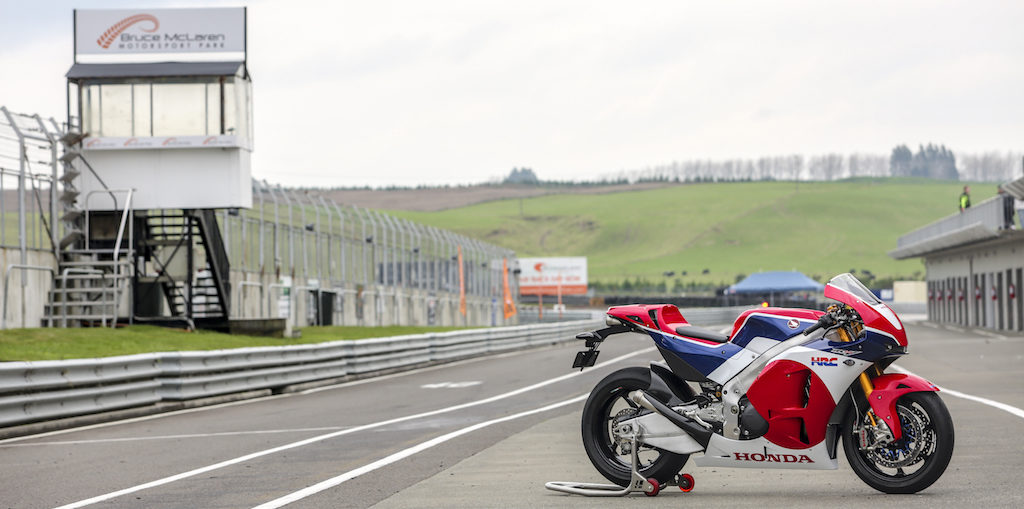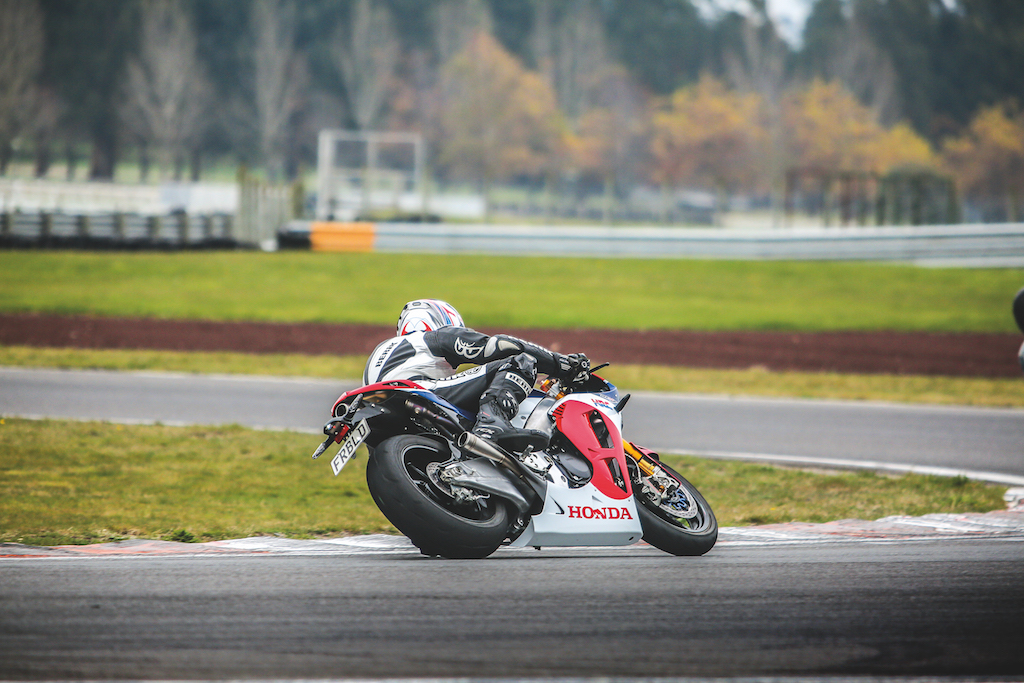With only two of Honda’s road-going MotoGP replica bikes making their way to New Zealand, having the opportunity to cut a few laps around Bruce McLaren Motorsport Park aboard one was a very special invite indeed. Paul headed along to see if he could play being Marc…
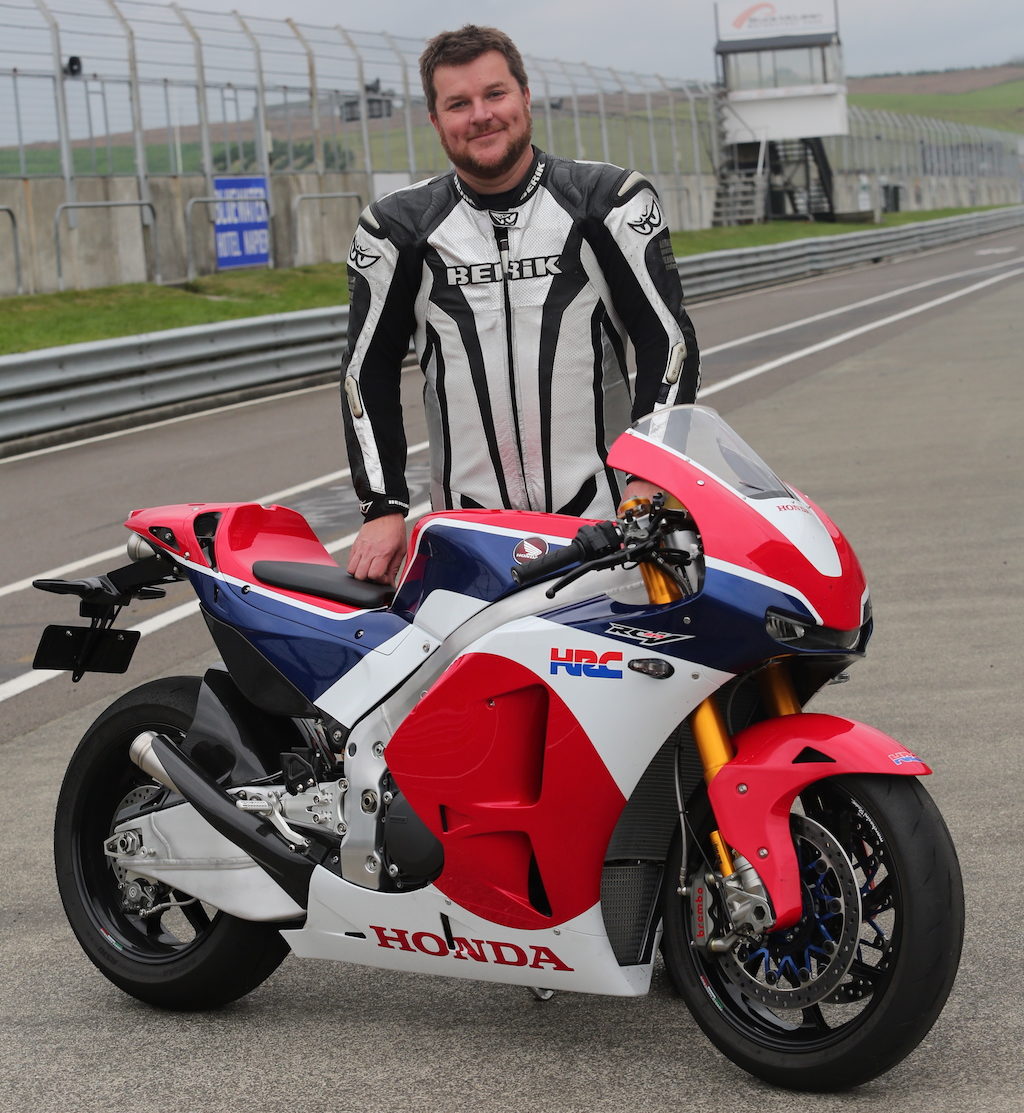 As someone kindly pointed out, I need to sell a few houses in BRM’s hometown of Paeroa to pay for this test bike if I happened to commit the ultimate sin and throw it into the kitty litter. With a crazy retail price of 188,000Euros when they were initially unveiled at Italy’s EICMA tradeshow in 2015 – and that’s presuming you could actually get on the list to buy one! – that wasn’t the end of the story, with a further 12,000Euros needed to be handed over if you wanted the race kit to unleash the true potential of the 999cc, 90-degree V4. Yep, that’s 200,000Euros (roughly $340,000NZD), and that’s before you get it into the country and give the government a bit more loose change in tax.
As someone kindly pointed out, I need to sell a few houses in BRM’s hometown of Paeroa to pay for this test bike if I happened to commit the ultimate sin and throw it into the kitty litter. With a crazy retail price of 188,000Euros when they were initially unveiled at Italy’s EICMA tradeshow in 2015 – and that’s presuming you could actually get on the list to buy one! – that wasn’t the end of the story, with a further 12,000Euros needed to be handed over if you wanted the race kit to unleash the true potential of the 999cc, 90-degree V4. Yep, that’s 200,000Euros (roughly $340,000NZD), and that’s before you get it into the country and give the government a bit more loose change in tax.
But this is a very special machine, with Honda wanting to give owners the MotoGP experience, though perhaps in a slightly milder package when it comes to outright horsepower. Put together by HRC technicians with all the attention normally reserved for the multi-million dollar MotoGP machines of Mssrs Maquez and Pedrosa, the RC213V-S shares around 80 percent of the components of the ‘real’ MotoGP machines including the Moriwaki-fabricated chassis, which is the one item that makes this machine standout from regular superbikes. The swingarm is a work of art, Öhlins gas forks are out of this world and the Brembo brakes are sublime, while the total weight of 170kilos is simply ridiculous. The V4 powerplant doesn’t feature the pneumatic valves of the MotoGP machines, and – in road form as we were testing – the RC213V-S is only pushing out 159hp, which is nothing compared to modern road-legal superbikes. But it’s the way in which the power is produced, combined with the rest of the package which makes this bike so special.
MOTOGP TECH
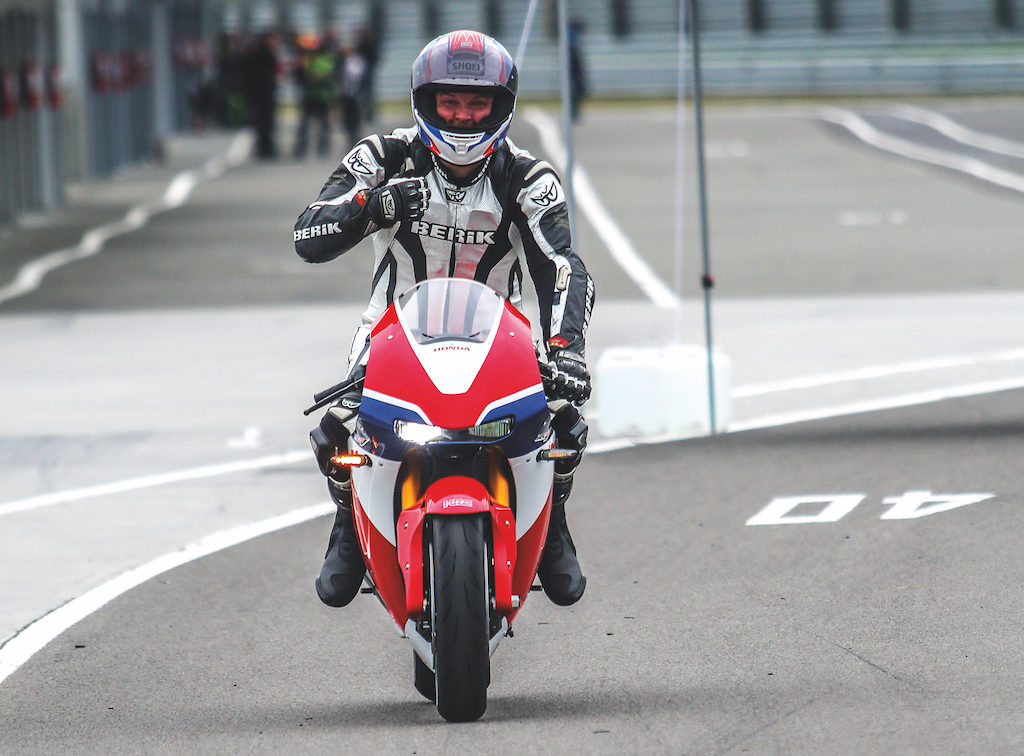 Simply pushing the Honda around to get it in the correct spot to take photos was nerve-wracking enough. But with this bike creating so much attention in the pits, simply trying to get it in a position without a crowd flocking around it, was a mission and a half.
Simply pushing the Honda around to get it in the correct spot to take photos was nerve-wracking enough. But with this bike creating so much attention in the pits, simply trying to get it in a position without a crowd flocking around it, was a mission and a half.
The RC213V-S is tiny. With a wheelbase of 1465mm, it’s marginally longer than Honda’s latest Fireblade, the SP1. But it was how close to the ground and compact the RC213V was that really took me by surprise, with the low seat accentuated by just how low the rest of the bike is. Where you’ll sit ‘in’ the seat of a regular superbike and the tank and fairing rise up in front of you, the RC213V stays low in front and behind the rider, with the attention to keeping the centre-of-gravity as low as possible one of the key features to making a great race bike. That sees the fuel tank positioned under the seat, with the bracing for the aluminium swingarm positioned underneath again to keep weight as low as possible.
Suspension – as you’d expect – is top-shelf Öhlins, with the gas-charged TTX25 USD forks looking purposeful upfront, while the TTX36 Pro-Link monoshock with remote preload adjuster is nestled in the rear. Honda claim it’s the most sophisticated suspension fitted to any machine outside of the GP paddock and we wouldn’t disagree.
Braking is supplied by Brembo, with the Monobloc calipers gripping 320mm disc, although the carbon has been swapped out for stainless-steel items for ease of use and predictable performance in all conditions. You wouldn’t want to grab a handful of front brake on the road only to find the carbon discs didn’t have enough heat in them now, would you? Finally, magnesium Marchesini wheels keep unsprung weight to a minimum.
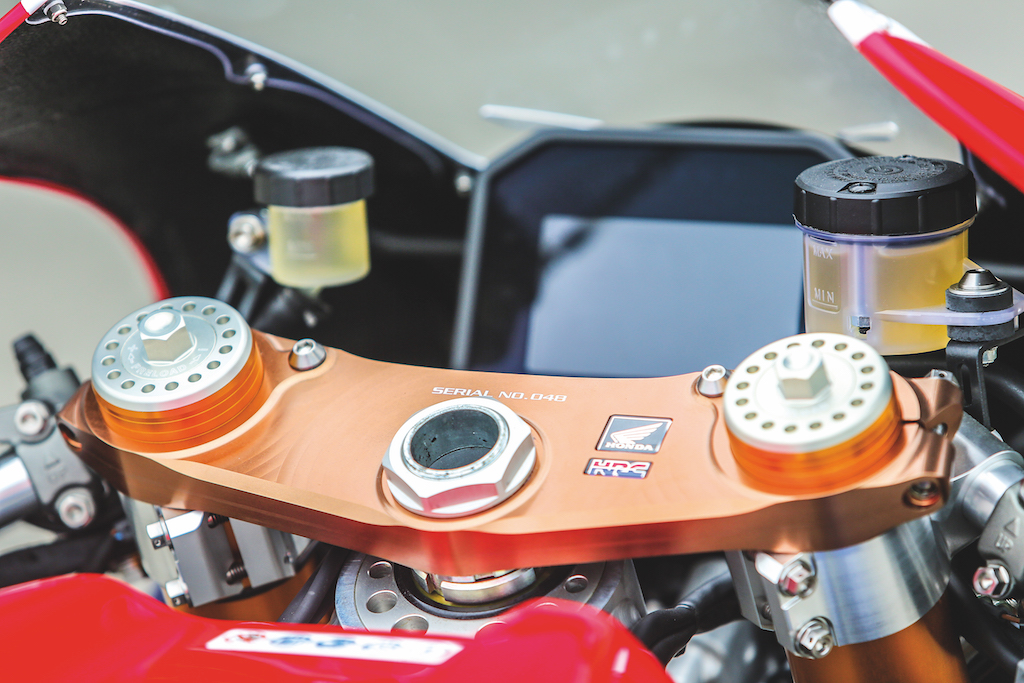 Looking at the cockpit of the RC213V-S and before you can do anything, you need the Honda Smart Key fob to be nearby before pressing the starter sees the TFT screen come to life. You can tell this model was produced at the same time Honda was working on the new CBR1000RR, with the same dash and electronic settings available on the MotoGP replica as you get on the road bike, only on a bigger scale. The modes can be swapped to change the delivery produced by the fly-by-wire throttle, while traction control, engine braking – which is four-way adjustable – torque control and wheel lift can also be adjusted. A slip-and-assist clutch stops chatter when changing down gears rapidly on the conventionally patterned six-speed gearbox, while also increasing engagement when under power while giving a light feel.
Looking at the cockpit of the RC213V-S and before you can do anything, you need the Honda Smart Key fob to be nearby before pressing the starter sees the TFT screen come to life. You can tell this model was produced at the same time Honda was working on the new CBR1000RR, with the same dash and electronic settings available on the MotoGP replica as you get on the road bike, only on a bigger scale. The modes can be swapped to change the delivery produced by the fly-by-wire throttle, while traction control, engine braking – which is four-way adjustable – torque control and wheel lift can also be adjusted. A slip-and-assist clutch stops chatter when changing down gears rapidly on the conventionally patterned six-speed gearbox, while also increasing engagement when under power while giving a light feel.
Finally, the engine is a 1000cc 90-degree V4 complete with dual, gear-driven overhead cams and a 360-degree crank. There’s four titanium valves on each head, although the pneumatic system of the race machines which allows such heady rev ceilings, was replaced with conventional coil springs in order to reduce maintenance. With the RC213V-S already requiring specialist Honda engineers to perform much of the service work (like derestricting the bike after run in), and the Öhlins forks needing specialist attention to keep them performing consistently, it was a nod towards making the replica slightly less service intensive.
NERVOUS INTOXICATION
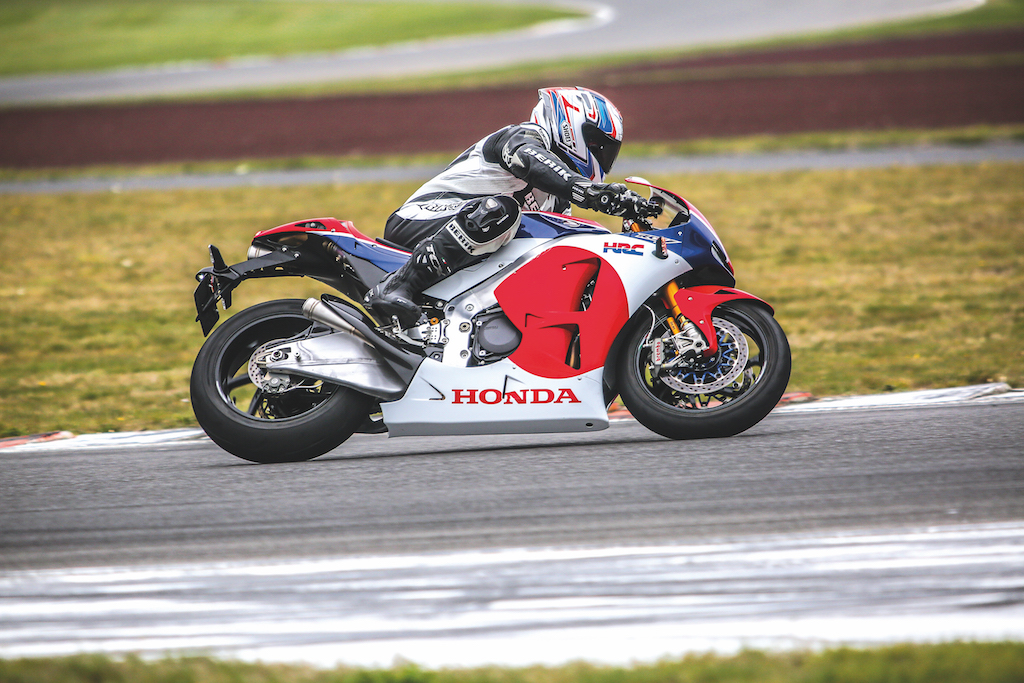 As you’d expect, there was a decent crowd hanging around the Honda when it came my turn to take the fob, press the starter and fire the V4 into life. Thankfully, I wasn’t the first one to show the RC213V what a Kiwi racetrack looked like, with the man who made the whole test possible – Gavin Sokolich – making sure he was first to scrub the standard Bridgestone R10 rubber in and make sure the Honda was up to temperature. With the owner, DJ legend and motorcycle nut, Carl Cox signalling that he was happy for Gavin to release his version of art collecting to the sweaty hands of BRM Magazine, it was still with a fair share of nervousness that I pulled my gloves on and headed off down pit-lane.
As you’d expect, there was a decent crowd hanging around the Honda when it came my turn to take the fob, press the starter and fire the V4 into life. Thankfully, I wasn’t the first one to show the RC213V what a Kiwi racetrack looked like, with the man who made the whole test possible – Gavin Sokolich – making sure he was first to scrub the standard Bridgestone R10 rubber in and make sure the Honda was up to temperature. With the owner, DJ legend and motorcycle nut, Carl Cox signalling that he was happy for Gavin to release his version of art collecting to the sweaty hands of BRM Magazine, it was still with a fair share of nervousness that I pulled my gloves on and headed off down pit-lane.
With a quick flick from side-to-side heading towards pit exit to get a quick feel of just how fast the Honda steered, it was a shock to the system that this was going to be an experience nothing remotely similar to riding a superbike, or even a litre-class race-bike. With the weight retained so low within the MotoGP chassis, the RCV changes direction more like a 250GP machine, just without the backbreaking/knee straining riding position of the small 2-stroke. Oh, and there’s a bit more power available too…
Despite the similarities in the cockpit, there’s not even a hint of familiarity to Honda’s flagship sportsbike, the Fireblade. The lack of mass in front of you makes the RCV much less intimidating than a sportsbike, with Jay Lawrence hitting the nail on the head afterwards when he said you just needed to dip a shoulder to get the RC to change direction. With your head positioned almost over the cockpit, you can see why the MotoGP boys ride like they do, with their body positioned almost ahead and below of the headstock, making the MotoGP machines change direction by weight transfer alone.
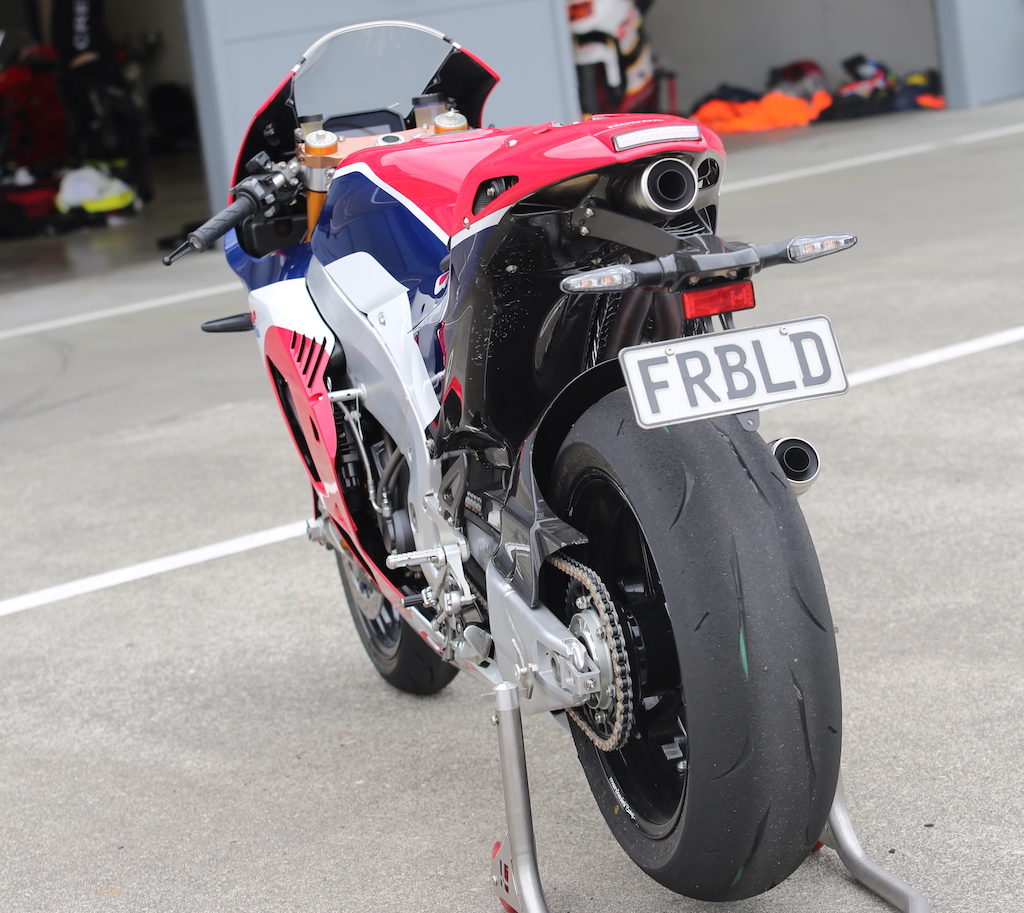 The riding position wasn’t cramped, although trying to get my left foot moving quick enough to flick through the six-speed gearbox using the excellent quickshifter, meant I was constantly changing position on the tight and twisting track 2 at Taupo. Okay, it’s not the seamless gearbox variety that the MotoGP boys get to use, but the quickshifter made grabbing the next cog up without rolling off effortless, although it was a surprise to find there was no autoblipper shifter for the journey back down. Making it worse, was the fact the RC was severely limited, with a rev ceiling of 8,000rpm giving a hint of the fun that was to come before hitting a frustrating limiter. Unbeknown to Gavin – the RC213V-S doesn’t come with a handbook – the motor must be limited until it passes a run-in period, where a visit by an engineer from Japan needs to be arranged to get the electronics disabled.
The riding position wasn’t cramped, although trying to get my left foot moving quick enough to flick through the six-speed gearbox using the excellent quickshifter, meant I was constantly changing position on the tight and twisting track 2 at Taupo. Okay, it’s not the seamless gearbox variety that the MotoGP boys get to use, but the quickshifter made grabbing the next cog up without rolling off effortless, although it was a surprise to find there was no autoblipper shifter for the journey back down. Making it worse, was the fact the RC was severely limited, with a rev ceiling of 8,000rpm giving a hint of the fun that was to come before hitting a frustrating limiter. Unbeknown to Gavin – the RC213V-S doesn’t come with a handbook – the motor must be limited until it passes a run-in period, where a visit by an engineer from Japan needs to be arranged to get the electronics disabled.
At the same time, it would be a good move to get the race-kit fitted, which not only shaves another 10kilos off the weight of the RC making it a crazily light 164kilos, but also increases power to 215hp and adds another 2,000rpm to the rev ceiling, letting the V4 keep going to 14,000rpm. As it was, I was just getting a taste of how silky smooth the Honda powerplant is, with the power building in a seamless surge from low in the rev range, getting stronger at 6,000 rpm before signing off at 8,000. It was frustrating, but didn’t hinder the experience of sampling the sort of chassis technology that only a small privileged group of very fast men get to discover.
Pulling the folding Brembo brake lever deeper into turn 1 at the end of the short straight, highlighted the low mass of the RC, with the gas-charged Öhlins having little in the way of travel, yet supplying incredible levels of feedback with what the front Bridgestone is doing. The power from the brakes isn’t fierce, with some Kiwi superbikes undoubtedly having stronger stoppers, but the lack of inertia from the svelte RC213V-S encourages you to grab them harder and later.
The slipper clutch encourages you to drop a few cogs at a time, something that was probably more required for us, as the lower rev ceiling meant you were furiously flicking up gears while trying to stop bumping into the limiter. A gear higher in the turns soon became the answer to keep up corner speed, although a press of the mode button sitting almost as an afterthought on the left-hand switchblock was soon required to stop the electronics from limiting drive when getting on the throttle mid-turn. The instant drive from the V4 – even at low revs – was so predictable in its delivery, that getting on the throttle earlier wasn’t a scary prospect, despite the price tag of the bike making crashing a horrible thought.
PASS THE FOB
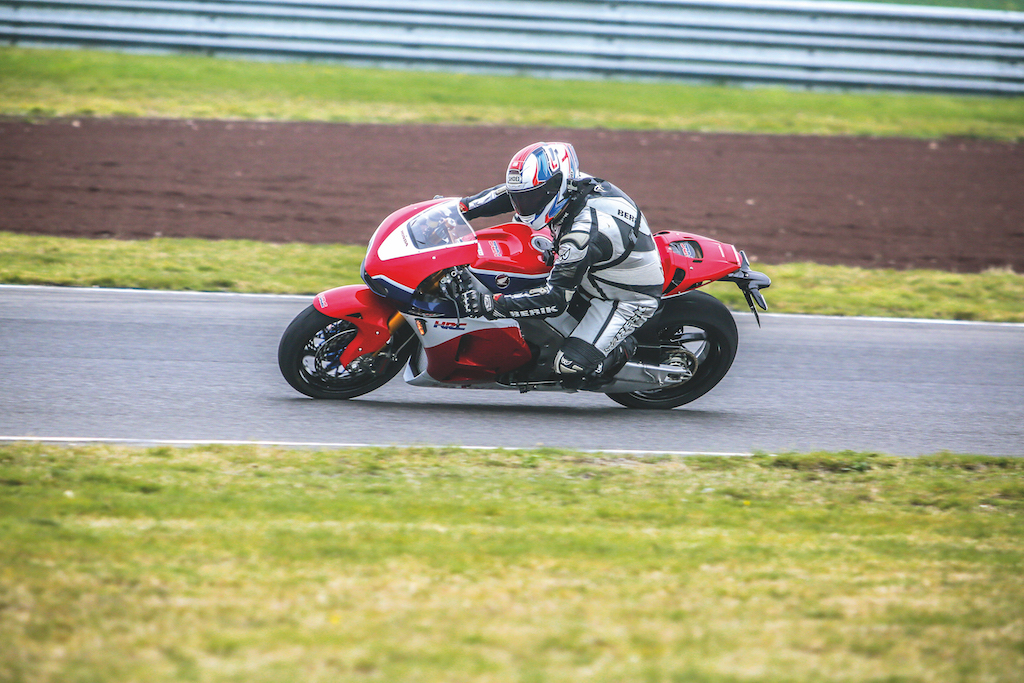 With a couple of sessions under my belt, it was with mixed emotions that I handed the Honda Smart Key back to Gavin and thus ended my time with an incredible machine, a ride which will undoubtedly stay in my mind for years to come. Getting a glimpse of what the riders of the world’s best machines in the world’s premier race class get to experience was an incredible privilege. Okay, I didn’t have the power anywhere near what they are able to tap into and I’m in no way experienced enough to reach the limits of the RC213V-S, but that’s okay, as that wasn’t what Honda made this bike for. It’s not a machine designed to win races, but instead offer an insight into what these guys get to feel.
With a couple of sessions under my belt, it was with mixed emotions that I handed the Honda Smart Key back to Gavin and thus ended my time with an incredible machine, a ride which will undoubtedly stay in my mind for years to come. Getting a glimpse of what the riders of the world’s best machines in the world’s premier race class get to experience was an incredible privilege. Okay, I didn’t have the power anywhere near what they are able to tap into and I’m in no way experienced enough to reach the limits of the RC213V-S, but that’s okay, as that wasn’t what Honda made this bike for. It’s not a machine designed to win races, but instead offer an insight into what these guys get to feel.
What amazed me was how easy it was to ride. Gone are the days where racebikes are fire-breathing machines which can only be tamed by demi-gods. Motorcycle engineers working out especially in the move to 4-strokes, that an easy machine is often a fast machine.
I was lucky enough to ride Ducati’s version of a MotoGP bike for the road, the Desmosedici RR, a few years back, and the difference is massive. While the Ducati was raw, loud, hard and always letting you know it could chew you up and spit you out at a moment’s notice, the Honda tried to make things easy, allowing you to concentrate on hitting braking markers and aiming for apexes. But looking at the two manufacturers and their current crop of road-going superbikes and you could imagine that being the case without swinging a leg over either of them.

